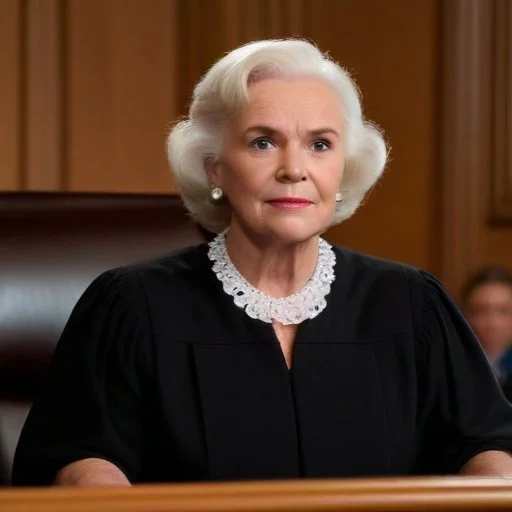Sandra Day O'Connor becomes first female Supreme Court justice
Sandra Day O'Connor made history on this day, shattering the glass ceiling as the U.S. Senate unanimously votes to confirm her as the first female Supreme Court justice! This trailblazing Arizona native, with her impressive resume and no-nonsense attitude, won over the hearts of even the toughest critics, securing a 99-0 vote. As a fierce advocate for women's rights and a seasoned judge, O'Connor was poised to bring a fresh perspective to the highest court in the land.
Sandra Day O'Connor: A Trailblazing Figure in American Jurisprudence
A Historic Moment of Unanimous Approval
On a momentous day in July 1981, the United States Senate made history by unanimously confirming
Sandra Day O'Connor as the first female Justice of the Supreme Court. This unprecedented decision marked a significant milestone in the struggle for gender equality in the American judiciary, as O'Connor became the 102nd Justice to serve on the highest court in the land.
Early Life and Career
Born on March 26, 1930, in El Paso, Texas, Sandra Day O'Connor grew up on the Lazy B Ranch in southeastern Arizona. Her early life was characterized by hard work, discipline, and a strong sense of independence, traits that would later define her remarkable career. O'Connor graduated from Stanford University in 1950 with a degree in economics and later earned her law degree from Stanford Law School in 1952. After serving in various legal capacities, including as a civilian attorney for the U.S. Army Quartermaster Corps, O'Connor entered politics in 1965, when she was elected to the Arizona Senate.
A Rising Star in Arizona Politics
O'Connor's political star rose rapidly in Arizona, where she served as the state's first female Majority Leader from 1973 to 1974. Her impressive legislative record, marked by a keen sense of fiscal responsibility and a commitment to social justice, earned her the respect of her peers and the admiration of her constituents. In 1975, O'Connor was appointed to the Arizona Court of Appeals, where she honed her judicial skills and developed a reputation as a fair-minded and incisive jurist.
The Historic Nomination and Confirmation
On July 7, 1981, President
Ronald Reagan nominated Sandra Day O'Connor to the Supreme Court, citing her "outstanding judicial and political credentials" and her "commitment to the principles of law and justice." The Senate Judiciary Committee held a swift and cordial confirmation hearing, during which O'Connor's exemplary qualifications, integrity, and judicial temperament were universally praised. On September 21, 1981, the full Senate voted unanimously to confirm O'Connor as the first female Justice of the Supreme Court, with a resounding 99-0 vote.
A Supreme Court Career Marked by Independence and Fairness
During her 24-year tenure on the Supreme Court, O'Connor established herself as a powerful voice for moderation, judicial restraint, and social justice. She authored landmark opinions in cases such as
Planned Parenthood v. Casey (1992) and
Grutter v. Bollinger (2003), which helped to shape American jurisprudence on issues ranging from abortion rights to affirmative action. O'Connor's independence, fairness, and commitment to the Constitution earned her widespread admiration and respect from across the political spectrum.
Legacy and Impact
Sandra Day O'Connor's trailblazing appointment to the Supreme Court has had a profound and lasting impact on American society. Her historic confirmation paved the way for future generations of women in law and politics, inspiring countless individuals to pursue careers in public service. As a Justice, O'Connor played a vital role in shaping the Court's decisions, often providing a decisive swing vote in closely divided cases. Today, her legacy continues to inspire and empower individuals from all walks of life, cementing her place as one of the most influential figures in American legal history.
Timeline of Key Events
- March 26, 1930: Sandra Day O'Connor born in El Paso, Texas
- 1950: Graduates from Stanford University with a degree in economics
- 1952: Earns law degree from Stanford Law School
- 1965: Elected to the Arizona Senate
- 1973-1974: Serves as Arizona's first female Majority Leader
- 1975: Appointed to the Arizona Court of Appeals
- July 7, 1981: Nominated to the Supreme Court by President Ronald Reagan
- September 21, 1981: Unanimously confirmed by the U.S. Senate
- January 25, 2006: Announces her retirement from the Supreme Court
Awards and Honors
Sandra Day O'Connor has received numerous awards and honors for her remarkable contributions to American jurisprudence, including:
- The Presidential Medal of Freedom (2009)
- The Congressional Gold Medal (2008)
- The American Bar Association's highest honor, the American Bar Association Medal (2008)
A Lasting Legacy
As the first female Justice of the Supreme Court, Sandra Day O'Connor has left an indelible mark on American history. Her extraordinary life and career serve as a testament to the power of hard work, determination, and a commitment to public service. As a trailblazing figure in American jurisprudence, O'Connor's legacy will continue to inspire and empower generations to come.

Comprehensive Character Portrait
A Strong Sense of Self
Sandra Day O'Connor's early life on the Lazy B Ranch in southeastern Arizona instilled in her a strong sense of self-reliance and independence. Her parents, Harry and Ada Day, taught her the importance of hard work, discipline, and resilience, which would become hallmarks of her later career.
O'Connor's personality was shaped by her rural upbringing, where she learned to fix fences, herd cattle, and navigate the rugged terrain of the American Southwest. These early experiences bred in her a confidence and self-assurance that would serve her well in her future endeavors.

Examination of Cultural Influence
A Cultural Icon
Sandra Day O'Connor's appointment to the Supreme Court in 1981 was a watershed moment in American cultural history. Her confirmation marked a significant shift in the national conversation about gender, power, and equality.
As the first woman to serve on the highest court in the land, O'Connor became an overnight sensation, inspiring countless young women and girls across the country to pursue careers in law, politics, and public service. Her groundbreaking achievement paved the way for future generations of women to break down barriers and shatter glass ceilings.
Political Influence Analysis
A Republican with a Twist
Sandra Day O'Connor's political philosophy was shaped by her conservative upbringing and her experience as a Republican politician in Arizona. However, her moderate stance on many issues often put her at odds with her party's more conservative wing.
Despite being appointed by President Ronald Reagan, O'Connor's commitment to judicial restraint and social justice led her to author landmark opinions that expanded individual rights and liberties. Her unique blend of conservative and liberal principles made her a crucial swing vote on the Court, earning her both praise and criticism from across the political spectrum.

Thorough Historical Narrative
A Pivotal Moment in Senate History
The Senate's unanimous confirmation of Sandra Day O'Connor on September 21, 1981, was a remarkable moment in the chamber's history. The 99-0 vote marked a rare instance of bipartisan unity, as senators from both parties put aside their differences to welcome the first woman to the Supreme Court.
The confirmation hearing was characterized by a sense of cordiality and respect, with senators from both parties praising O'Connor's judicial temperament, legal acumen, and commitment to public service. The vote itself was a testament to O'Connor's broad appeal and her ability to build bridges across party lines.
Rich Educational Impact Review
A New Era in Legal Education
Sandra Day O'Connor's appointment to the Supreme Court marked a turning point in legal education, as law schools across the country began to take notice of the changing demographics of the legal profession.
O'Connor's trailblazing example inspired a new generation of young women to pursue careers in law, leading to a significant increase in female enrollment in law schools. Her commitment to social justice and her advocacy for diversity and inclusion also reshaped the legal curriculum, as law schools began to integrate courses on gender, race, and social justice into their programs.


